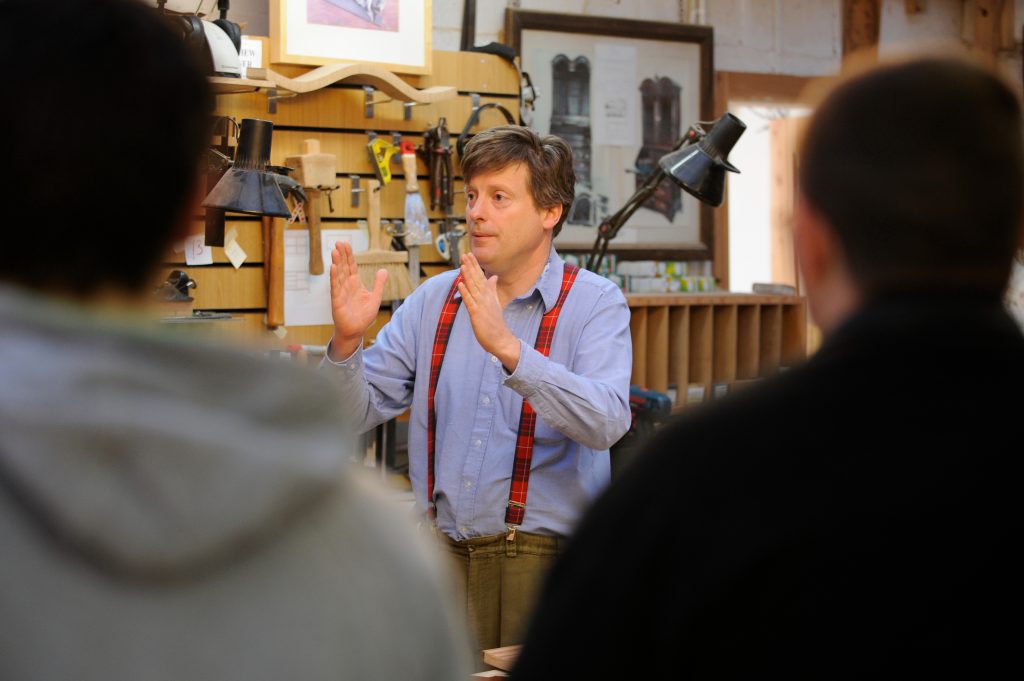Anselm Fraser, principal of the Chippendale school, is writing a series of exclusive articles for The Woodworker magazine. Here’s the second of his articles.
Last month I looked at the mental benefits that woodworking can bring, citing a book Flow: The Psychology of the Optimal Experience by University of Chicago psychologist Mihaly Csikszentmihalyi.
He describes such things as the challenges involved in a creative pursuit and the degree of concentration as “elements of enjoyment” – the things that free our minds and give us greatest satisfaction.
Those elements are found in abundance in woodworking and is the reason why, for example, Help for Heroes, the charity for injured ex-Services personnel, and NHS Great Glasgow and Clyde promote woodworking classes.
The reason why woodworking is so good for mental well-being is that it’s an effective form of art therapy. You aren’t just doing one thing: you’re starting with raw wood and, step by step, working it into something beautiful or useful.
In effect, you are using multiple parts of your brain and challenging yourself to think in new and creative ways.
Goals and objectives
In that sense, woodworking is a “whole-brain activity.” The mental activities involved in planning, designing, and the hand-eye co-ordination involved in the woodworking processes fires up every part of your brain.
The first element, psychologists agree, is setting goals and objectives, and this is what I’d like to look at this month because your woodworking objectives should be specific, measurable, achievable, realistic, and timely (in other words SMART).
It doesn’t matter whether you’re an amateur hobbyist or a professional furniture maker, SMART thinking to a healthier and more productive you is all about setting clear objectives that are challenging but not impossible.
For example, you might love to beat Usain Bolt’s record for the 100 metres. But there would be no point in setting that as a goal. It would simply end up in disappointment. Instead, what you could do is set a goal to get a little fitter and take up jogging
Equally, in a woodworking context, you can’t set yourself a goal of making a chest of drawers by next Friday if you don’t know much about woodworking. First decide what skills you need to acquire. What smaller and more basic pieces you could work on first to hone your skills.
It’s a process of setting smaller objectives in pursuit of that larger goal of a chest of drawers. It’s about setting out a timetable for achieving them that doesn’t involve you working until 3am every night (and do remember that working with machinery or dangerous tools should never be attempted when tired).
In achieving each smaller objective, the idea is to keep your morale high by not setting unrealistic targets or timetables. The whole idea of woodworking is that it should be fun, and demoralising yourself takes away the fun.
I have always felt that a skill learned with pleasure is a skill that you’ll retain for a lifetime, and one of the great pleasures of woodworking is that there is always something new to learn.
Discomfort zone
But in learning new skills and closing in on that chest of drawers, don’t set goals that are too easy. There should be a small element of risk to push you along and keep you motivated.
It’s putting yourself in a “discomfort zone” – a mental place where there is some doubt and uncertainty about whether you’re going to satisfactorily meet your objective on time.
Think Noah, for example, one of the world’s first woodworkers. God gave Noah the task of building an Ark out of cypress wood, 300 cubits long, 50 cubits wide and 30 cubits high.
This means that the Ark, if it ever existed, would have been about 450 feet long, and the size of a four-storey building. Noah would have had to learn a great deal, setting lots of smaller objectives, to fulfil his goal of building the Ark.
Yet Noah was an amateur. The Titanic was built by professionals.
